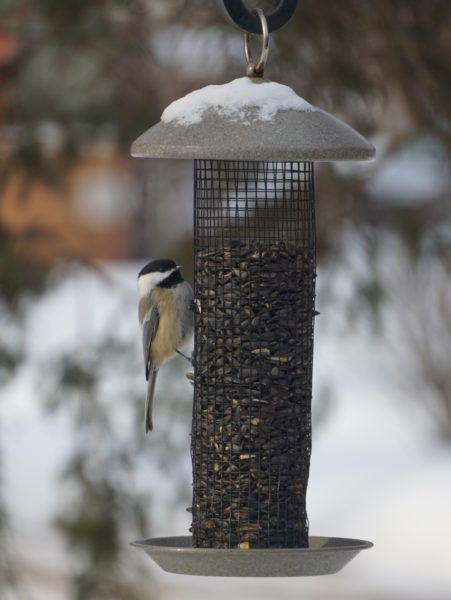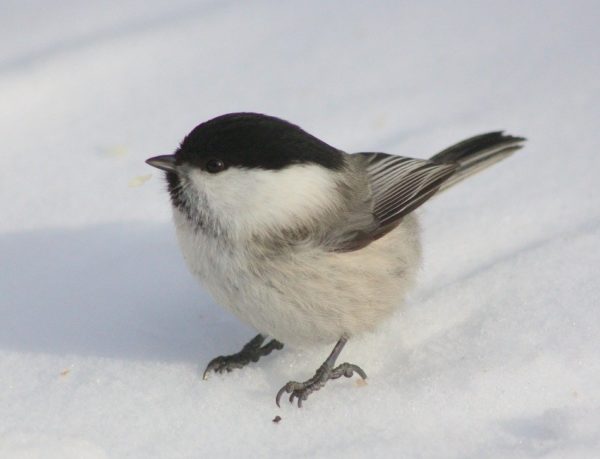Finding food can be a challenge for birds in wintertime, so many people choose to provide backyard bird feeders during the colder months. Birds can’t rely entirely on food from bird feeders, but feeders can provide supplementary nutrition that can help give birds the energy they need to survive the season’s cold temperatures. Having a bird feeder in your yard can also be a rewarding experience, offering interesting insight into the lives and habits of birds.
Feeding Tips
 Deciding where to locate a bird feeder is important. Feeders should be placed in open areas, but with trees or shrubs nearby where songbirds can find shelter from the weather and from predators. Make sure that feeders are located in areas that are protected from wind, as well as from moisture. (Discard any food that gets wet from rain or snow, as it can turn moldy). Other animals can be attracted to feeders as well. If using a pole feeder, baffles are available to keep squirrels and raccoons away. If you live in areas where bears are common, it is advisable to take feeders down at night. Although bears are generally in hibernation this time of year, bird feeders will become attractive to them as it gets closer to spring. For helpful tips see Colorado Parks & Wildlife (CPW)’s Attracting Birds, Not Bears brochure. Finally, be sure to place feeders safely away from areas where cats frequent. Domestic cats are one of the greatest dangers faced by songbirds.
Deciding where to locate a bird feeder is important. Feeders should be placed in open areas, but with trees or shrubs nearby where songbirds can find shelter from the weather and from predators. Make sure that feeders are located in areas that are protected from wind, as well as from moisture. (Discard any food that gets wet from rain or snow, as it can turn moldy). Other animals can be attracted to feeders as well. If using a pole feeder, baffles are available to keep squirrels and raccoons away. If you live in areas where bears are common, it is advisable to take feeders down at night. Although bears are generally in hibernation this time of year, bird feeders will become attractive to them as it gets closer to spring. For helpful tips see Colorado Parks & Wildlife (CPW)’s Attracting Birds, Not Bears brochure. Finally, be sure to place feeders safely away from areas where cats frequent. Domestic cats are one of the greatest dangers faced by songbirds.
A variety of foods, such as thistle, seeds, nuts, suet, and mealworms, are available for feeders. For example, thistle is attractive to goldfinches and pine siskins, while sparrows, chickadees, and other common winter songbirds prefer sunflower seeds and millet. Suet, a mixture of animal fat that is sometimes prepared with nuts and berries, is preferred by woodpeckers and nuthatches. Crows, doves, and other larger birds will eat cracked corn, and jays enjoy peanuts. For more information on the different types of food and feeders, see CPW’s Winter Viewing Tips website and their publication Feeding Birds.
When feeding birds, consider also providing a birdbath in your yard. Birdbaths provide much-needed water for birds, especially during periods of low precipitation where water can be difficult to find. Water should be changed frequently to reduce the risk of parasites and diseases, and special heaters are available that can keep the water from freezing.
Finally, don’t forget to have a field guide handy, so you can identify which species pay you a visit!
Keep Feeders Clean
Choosing to provide bird feeders means a commitment to making sure the feeders are clean, healthy, and sanitary. Feeders that are not cleaned regularly are a common cause of bird diseases such as finch eye disease, salmonella, and others. To prevent diseases at bird feeders, clean them regularly, make sure they are placed high off the ground, and keep other animals away. Additional information and photos can be found in CPW’s Diseases at Feeders fact sheet.
Got Feeders? Participate in the Christmas Bird Count!
 Every year, birding organizations across North America conduct the Christmas Bird Count, a citizen science initiative aimed at tracking bird populations in winter. If you have birds in your backyard, you can participate! This year’s Christmas Bird Count runs from December 14 to January 5. For more information and how to get started, visit CPW’s website.
Every year, birding organizations across North America conduct the Christmas Bird Count, a citizen science initiative aimed at tracking bird populations in winter. If you have birds in your backyard, you can participate! This year’s Christmas Bird Count runs from December 14 to January 5. For more information and how to get started, visit CPW’s website.
- How to Spot the Differences Between Eagles and Hawks - August 16, 2021
- How Transportation Projects Help Tell the Story of Colorado’s Past - August 9, 2021
- Time Machine Tuesday: The Night the Castlewood Canyon Dam Gave Way - August 3, 2021